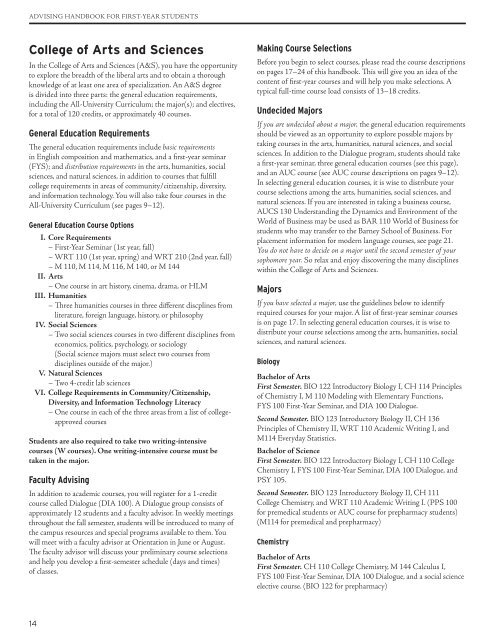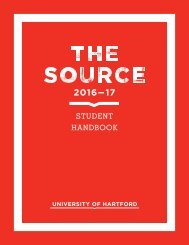advising
You also want an ePaper? Increase the reach of your titles
YUMPU automatically turns print PDFs into web optimized ePapers that Google loves.
ADVISING HANDBOOK FOR FIRST-YEAR STUDENTS<br />
College of Arts and Sciences<br />
In the College of Arts and Sciences (A&S), you have the opportunity<br />
to explore the breadth of the liberal arts and to obtain a thorough<br />
knowledge of at least one area of specialization. An A&S degree<br />
is divided into three parts: the general education requirements,<br />
including the All-University Curriculum; the major(s); and electives,<br />
for a total of 120 credits, or approximately 40 courses.<br />
General Education Requirements<br />
The general education requirements include basic requirements<br />
in English composition and mathematics, and a first-year seminar<br />
(FYS); and distribution requirements in the arts, humanities, social<br />
sciences, and natural sciences, in addition to courses that fulfill<br />
college requirements in areas of community/citizenship, diversity,<br />
and information technology. You will also take four courses in the<br />
All-University Curriculum (see pages 9–12).<br />
General Education Course Options<br />
I. Core Requirements<br />
– First-Year Seminar (1st year, fall)<br />
– WRT 110 (1st year, spring) and WRT 210 (2nd year, fall)<br />
– M 110, M 114, M 116, M 140, or M 144<br />
II. Arts<br />
– One course in art history, cinema, drama, or HLM<br />
III. Humanities<br />
– Three humanities courses in three different discplines from<br />
literature, foreign language, history, or philosophy<br />
IV. Social Sciences<br />
– Two social sciences courses in two different disciplines from<br />
economics, politics, psychology, or sociology<br />
(Social science majors must select two courses from<br />
disciplines outside of the major.)<br />
V. Natural Sciences<br />
– Two 4-credit lab sciences<br />
VI. College Requirements in Community/Citizenship,<br />
Diversity, and Information Technology Literacy<br />
– One course in each of the three areas from a list of collegeapproved<br />
courses<br />
Students are also required to take two writing-intensive<br />
courses (W courses). One writing-intensive course must be<br />
taken in the major.<br />
Faculty Advising<br />
In addition to academic courses, you will register for a 1-credit<br />
course called Dialogue (DIA 100). A Dialogue group consists of<br />
approximately 12 students and a faculty advisor. In weekly meetings<br />
throughout the fall semester, students will be introduced to many of<br />
the campus resources and special programs available to them. You<br />
will meet with a faculty advisor at Orientation in June or August.<br />
The faculty advisor will discuss your preliminary course selections<br />
and help you develop a first-semester schedule (days and times)<br />
of classes.<br />
Making Course Selections<br />
Before you begin to select courses, please read the course descriptions<br />
on pages 17–24 of this handbook. This will give you an idea of the<br />
content of first-year courses and will help you make selections. A<br />
typical full-time course load consists of 13–18 credits.<br />
Undecided Majors<br />
If you are undecided about a major, the general education requirements<br />
should be viewed as an opportunity to explore possible majors by<br />
taking courses in the arts, humanities, natural sciences, and social<br />
sciences. In addition to the Dialogue program, students should take<br />
a first-year seminar, three general education courses (see this page),<br />
and an AUC course (see AUC course descriptions on pages 9–12).<br />
In selecting general education courses, it is wise to distribute your<br />
course selections among the arts, humanities, social sciences, and<br />
natural sciences. If you are interested in taking a business course,<br />
AUCS 130 Understanding the Dynamics and Environment of the<br />
World of Business may be used as BAR 110 World of Business for<br />
students who may transfer to the Barney School of Business. For<br />
placement information for modern language courses, see page 21.<br />
You do not have to decide on a major until the second semester of your<br />
sophomore year. So relax and enjoy discovering the many disciplines<br />
within the College of Arts and Sciences.<br />
Majors<br />
If you have selected a major, use the guidelines below to identify<br />
required courses for your major. A list of first-year seminar courses<br />
is on page 17. In selecting general education courses, it is wise to<br />
distribute your course selections among the arts, humanities, social<br />
sciences, and natural sciences.<br />
Biology<br />
Bachelor of Arts<br />
First Semester. BIO 122 Introductory Biology I, CH 114 Principles<br />
of Chemistry I, M 110 Modeling with Elementary Functions,<br />
FYS 100 First-Year Seminar, and DIA 100 Dialogue.<br />
Second Semester. BIO 123 Introductory Biology II, CH 136<br />
Principles of Chemistry II, WRT 110 Academic Writing I, and<br />
M114 Everyday Statistics.<br />
Bachelor of Science<br />
First Semester. BIO 122 Introductory Biology I, CH 110 College<br />
Chemistry I, FYS 100 First-Year Seminar, DIA 100 Dialogue, and<br />
PSY 105.<br />
Second Semester. BIO 123 Introductory Biology II, CH 111<br />
College Chemistry, and WRT 110 Academic Writing I. (PPS 100<br />
for premedical students or AUC course for prepharmacy students)<br />
(M114 for premedical and prepharmacy)<br />
Chemistry<br />
Bachelor of Arts<br />
First Semester. CH 110 College Chemistry, M 144 Calculus I,<br />
FYS 100 First-Year Seminar, DIA 100 Dialogue, and a social science<br />
elective course. (BIO 122 for prepharmacy)<br />
14



